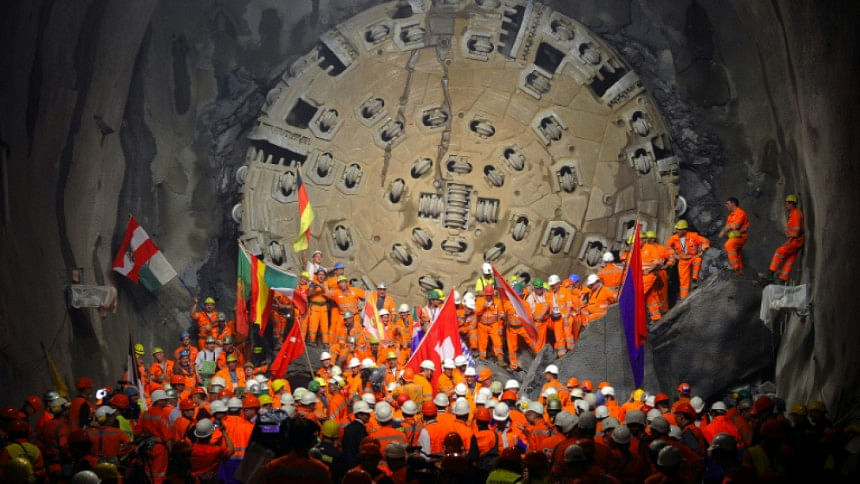World's longest rail tunnel sees light at end of decades' wait

When Swiss engineer Carl Eduard Gruner came up with the idea to build the world's longest rail tunnel under the Alps in 1947, he predicted the visionary project could be finished by the start of the 21st century.
He would turn out to be off by 16 years.
Gruner's sketch and technical paper called "Journey through the Gotthard Base Tunnel (GBT) in the year 2000" planted the seeds for a venture that will be launched this week and aims to transform travel through the heart of Europe.
Constructing the 57-kilometre (35-mile) rail tunnel took just over 12 billion Swiss francs ($12 billion, 11 billion euros) and some 2,400 workers, according to Swiss government statistics.
More than 28 million tonnes of rock had to be excavated from the mountain near the Gotthard pass.
The bumpy road from Gruner's initial idea to the official start of construction in 1999 included bureaucratic delays and concern over the project's financial viability.
Switzerland's federal government set up a committee in 1963 to look into the building of an alpine base tunnel but opinions were split over various proposals, before an official body eventually ruled in 1983 that the project was "not urgent."
Momentum in favour of the GBT built again ahead of a 1992 referendum, which supported the project, but public outcry about the expense put work on hold.
Eventually, a November 1998 referendum closed the deal, when 64 percent of Swiss voters approved the final plans along with funding schemes, including a new road tax.
ZURICH TO MILAN
"It's a big engineering achievement," said Martin Knights of the London-headquartered Institution of Civil Engineers.
The tunnel runs from Erstfeld in the central Swiss canton of Uri, to Bodio in southern Ticino canton, and will shave the train journey from Zurich to Milan in northern Italy down to two hours and 40 minutes, roughly an hour less than it currently takes.
The new route also aims to make rail freight more efficient, including by supporting heavier cargo, which should reduce the number of diesel-guzzling lorries on the roads, in turn improving traffic and curbing pollution.
The number of daily rail passengers is also expected to increase from the current rate of 9,000 people to 15,000 by 2020, according to the Swiss federal railway service.
In a study of the GBT's possible economic benefits, Swiss bank Credit Suisse forecast a range of positive impacts driven by an easier movement of goods, growth in day-trip tourism and higher property values in the affected cantons linked to increased accessibility.
German Chancellor Angela Merkel, French President Francois Hollande and Italian Prime Minister Matteo Renzi, along with Swiss officials, are due to attend Wednesday's grand opening, which will feature a ceremonial run.
Full service starts in December.
A 'MOVING FACTORY'
Had Gruner attempted to break ground on the tunnel when he conceived the idea 69 years ago, engineers would have had to undertake a costly and dangerous effort to blast and drill through a massive amount of mountain rock.
But the project benefited in the end from major technical advances in tunnel boring machines that began to pick up in the 1960s and 70s, Knights said.
The boring machinery used for the Gotthard Tunnel is "a whole moving factory, half a kilometre in length", which synchronises all the steps needed to carve a passage through a mountain, he said.
While cutting through the rock, the machine throws the debris backwards and simultaneously places the pre-formed segments of concrete that form the shape of the tunnel.
A separate system grouts the pieces together.
Editor of Ground Engineering magazine, Claire Smith, told AFP that the success of the ambitious Gotthard venture, which was completed on schedule, "has cleared the path for many other (similar) projects".
The GBT has been viewed as a trailblazer for a high-speed rail link between the French city of Lyon and Turin in northern Italy, which has faced delays and opposition from environmental groups.
It also paves the way for Austria's Brenner Tunnel, set to open in about a decade.
When it officially opens on Wednesday, the GBT will overtake Japan's 53.9-kilometre Seikan tunnel as the world's longest train tunnel and bump the 50.5-kilometre Channel Tunnel that links England and France into third place.
The Brenner Tunnel could however slot into second place when it opens, with an estimated length of 55 kilometres.

 For all latest news, follow The Daily Star's Google News channel.
For all latest news, follow The Daily Star's Google News channel. 




Comments